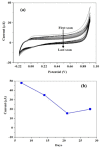Electrochemical Detection of Ascorbic Acid in Oranges at MWCNT-AONP Nanocomposite Fabricated Electrode
- PMID: 35214973
- PMCID: PMC8877794
- DOI: 10.3390/nano12040645
Electrochemical Detection of Ascorbic Acid in Oranges at MWCNT-AONP Nanocomposite Fabricated Electrode
Abstract
Ascorbic acid (AA) is an essential vitamin in the body, influencing collagen formation, as well as norepinephrine, folic acids, tryptophan, tyrosine, lysine, and neuronal hormone metabolism. This work reports on electrochemical detection of ascorbic acid (AA) in oranges using screen-print carbon electrodes (SPCEs) fabricated with multi-walled carbon nanotube- antimony oxide nanoparticle (MWCNT-AONP) nanocomposite. The nanocomposite-modified electrode displayed enhanced electron transfer and a better electrocatalytic reaction towards AA compared to other fabricated electrodes. The current response at the nanocomposite-modified electrode was four times bigger than the bare electrode. The sensitivity and limit of detection (LOD) at the nanocomposite modified electrode was 0.3663 [AA]/µM and 140 nM, respectively, with linearity from 0.16-0.640 μM and regression value R2 = 0.985, using square wave voltammetry (SWV) for AA detection. Two well-separated oxidation peaks were observed in a mixed system containing AA and serotonin (5-HT); and the sensitivity and LOD were 0.0224 [AA]/µA, and 5.85 µΜ, respectively, with a concentration range from 23 to 100 µM (R2 = 0.9969) for AA detection. The proposed sensor outperformed other AA sensors reported in the literature. The fabricated electrode showed great applicability with excellent recoveries ranging from 99 to 107 %, with a mean relative standard deviation (RSD) value of 3.52 % (n = 3) towards detecting AA in fresh oranges.
Keywords: antimony oxide nanoparticles; ascorbic acid; electrochemical sensors; nanocomposite; oranges.
Conflict of interest statement
The authors declare no conflict of interest.
Figures





Similar articles
-
Electrochemical Detection of Endosulfan Using an AONP-PANI-SWCNT Modified Glassy Carbon Electrode.Materials (Basel). 2021 Feb 4;14(4):723. doi: 10.3390/ma14040723. Materials (Basel). 2021. PMID: 33557284 Free PMC article.
-
Electrochemical detection of nanomolar dopamine in the presence of neurophysiological concentration of ascorbic acid and uric acid using charge-coated carbon nanotubes via facile and green preparation.Talanta. 2016 Jan 15;147:453-9. doi: 10.1016/j.talanta.2015.10.020. Epub 2015 Oct 8. Talanta. 2016. PMID: 26592632
-
Green Fabrication of Nonenzymatic Glucose Sensor Using Multi-Walled Carbon Nanotubes Decorated with Copper (II) Oxide Nanoparticles for Tear Fluid Analysis.Appl Biochem Biotechnol. 2022 Aug;194(8):3689-3705. doi: 10.1007/s12010-022-03936-2. Epub 2022 Apr 30. Appl Biochem Biotechnol. 2022. PMID: 35488956
-
Simultaneous electrochemical sensing of serotonin, dopamine and ascorbic acid by using a nanocomposite prepared from reduced graphene oxide, Fe3O4 and hydroxypropyl-β-cyclodextrin.Mikrochim Acta. 2019 Nov 7;186(12):751. doi: 10.1007/s00604-019-3861-3. Mikrochim Acta. 2019. PMID: 31701250
-
Serotonin level as a potent diabetes biomarker based on electrochemical sensing: a new approach in a zebra fish model.Anal Bioanal Chem. 2021 Mar;413(6):1615-1627. doi: 10.1007/s00216-020-03122-5. Epub 2021 Jan 26. Anal Bioanal Chem. 2021. PMID: 33501550
Cited by
-
Investigation of the photoactivation effect of TiO2 onto carbon-clay paste electrode by cyclic voltammetry analysis.Heliyon. 2023 Feb 4;9(2):e13474. doi: 10.1016/j.heliyon.2023.e13474. eCollection 2023 Feb. Heliyon. 2023. PMID: 36846689 Free PMC article.
-
Detection of Ascorbic Acid by Two-Dimensional Conductive Metal-Organic Framework-Based Electrochemical Sensors.Molecules. 2024 May 21;29(11):2413. doi: 10.3390/molecules29112413. Molecules. 2024. PMID: 38893288 Free PMC article.
-
A Sensitive and Accurate Electrochemical Sensor Based on Biomass-Derived Porous Carbon for the Detection of Ascorbic Acid.Molecules. 2025 Jul 15;30(14):2980. doi: 10.3390/molecules30142980. Molecules. 2025. PMID: 40733246 Free PMC article.
-
Cardiovascular Effects of Environmental Metal Antimony: Redox Dyshomeostasis as the Key Pathogenic Driver.Antioxid Redox Signal. 2023 Apr;38(10-12):803-823. doi: 10.1089/ars.2022.0185. Epub 2023 Feb 8. Antioxid Redox Signal. 2023. PMID: 36424825 Free PMC article. Review.
-
Recent advances in electrochemical sensors and biosensors for monitoring drugs and metabolites in pharmaceutical and biological samples.ADMET DMPK. 2023 May 1;11(2):151-173. doi: 10.5599/admet.1709. eCollection 2023. ADMET DMPK. 2023. PMID: 37325116 Free PMC article. Review.
References
-
- Fadhel D.H. Spectrophotometric determination of ascorbic acid in aqueous solutions. Al-Nahrain J. Sci. 2012;15:88–94. doi: 10.22401/JNUS.15.3.13. - DOI
Grants and funding
LinkOut - more resources
Full Text Sources
Research Materials

